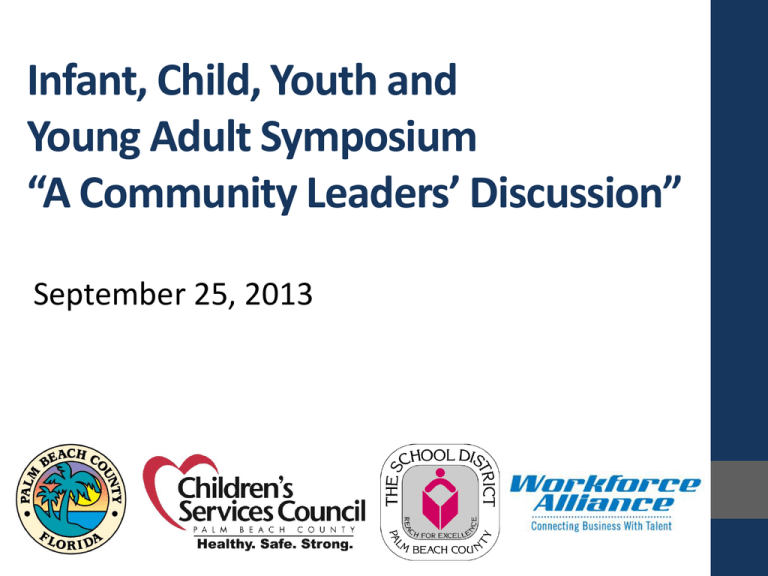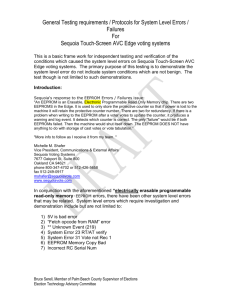Youth Symposium - TrustedPartner
advertisement

Infant, Child, Youth and Young Adult Symposium “A Community Leaders’ Discussion” September 25, 2013 Symposium Goal To share information and identify actions and programs to support the healthy growth, development and education of children and youth from prenatal to young adulthood. Agenda Symposium Goal & Agenda Overview Jon Van Arnam 1:00-1:10 Opening Remarks and Self Introductions Board Chairs 1:10-1:20 “Children Deserve Our Help to Succeed” Tana Ebbole 1:20-1:30 Staff Presentations – “Demographics, Key Factors & Recommendations” Lisa Williams-Taylor Marsha Guthrie Keith Oswald Mike Rodriguez Mimi Coenen 1:30-2:10 Keynote Presentation – “Essential Life Skills” Ellen Galinsky 2:10-2:45 Refreshment Break 2:45-3:00 Facilitated Roundtable Discussion Ellen Galinsky 3:00-4:30 Wrap-Up Ellen Galinsky 4:30-4:45 Closing Remarks Board Chairs 4:45-5:00 Keynote & Facilitator Ellen Galinsky • President and Co-Founder of Families and Work Institute Goal for Our Children and Youth To support the healthy growth, development and education of our children and youth prenatal through young adulthood so that they graduate from high school and succeed in life. Palm Beach County • 77% of our children (high school seniors) are graduating, leaving approximately 2,500 not receiving a standard diploma annually • 67% of all graduates go on to post-secondary education, leaving approximately 3,000 who do not • 5.1% (3,273) of youth ages 16-19 are not working and not in school Over-Represented Populations • Impoverished – 65% • Black and Hispanic – 64% and 72% • Exceptional Student Education (ESE) – 54% • English Language Learners (ELL) – 47% Cross-Sectional Input • Steering committee and three subcommittees • 50+ people • 25+ organizations Guiding Questions • What framework should we use? • What are the key factors impacting goal? • What do these key factors look like in Palm Beach County? • What can we do to make a difference – recommendations? Child/Youth Framework PrenatalBirth 3 Lead: Children’s Services Council Kindergarten Entry Third Grade Middle School Entry Lead: School District High School Entry High School Graduation Lead: Criminal Justice Commission & Workforce Alliance 22 Steps to Success Graduation & successful entry to adulthood Career readiness Connectedness Ready for school Effective parenting Healthy births Secure attachment to caregivers • Late or no Prenatal care Safe & nurturing families & communities • Toxic Stress Depression Substance Abuse Exposure to violence Prosocial adolescent behaviors Meeting educational standards • • • • Poor school attendance Non-proficient readers Discipline referrals/suspensions Not connected • DJJ Referrals • Teen pregnancy • Adolescents substance use • Idle youth (not working and not in school) Key Prenatal-Five Factors Impacting Goal • Prenatal care • Parenting • Toxic stress • Depression • Substance abuse • Exposure to violence • School readiness Key Factor: Prenatal Care • Prenatal care access - healthy babies and developmental delays • Preterm birth - third grade reading and math performance • Low and very low birthweight - poor school performance and chronic health issues. • In PBC, the rate of late or no prenatal care access is 6.9% compared to 4.8% for Florida Key Factor: Parenting • Secure, stable, supportive relationships brain development and school readiness • Parenting skills and knowledge of child development - protective factors • Sensitive and responsive parent/child relationships - cognitive skill development Key Factor: Toxic Stress Depression & Substance Abuse • Toxic stress - brain architecture and impact on learning, behavior, and physical and mental health • Depression - children’s behavior, IQ scores, impulsivity, and developmental delays • Postpartum Depression is estimated to occur in approximately 10 to 20 percent of new mothers – 2,100 in PBC • 2nd highest maltreatment type (verified) in PBC – “Substance Misuse” (302 cases - 21% in 2012) Key Factor: Toxic Stress Exposure to Violence • Exposure to violence - depression, post-traumatic stress disorder, substance abuse, poor physical health, and poor academic achievement • Emotional stability, self-regulation, problem solving skills and resilience are negatively affected by maltreatment • 1,207 children (0-5) were abused and neglected in PBC in 2012 • “Family Violence Threatens Child” was the most common maltreatment type (verified) in PBC (619 cases - 42% in 2012) Key Factor: School Readiness • Strongest predictors of later school achievement kindergarten-entry (math, reading, and attention skills) • 30% of our children are not ready based on kindergarten assessments • Preschool participants (3 & 4 year olds) • h High school completion • i School dropout • i Juvenile arrests • i Grade retention • i Special education Prenatal-Five Importance of First Five Years http://www.youtube.com/watch?v=oJg_KrPDNjY&feature=c4-overview&list=UUuf2Cqyx9J6LccjVbF8DV2g Kindergarten to High School Key School Factors Impacting Goal • Reading proficiency • Attendance • Discipline and suspensions • Connectedness Key Factor: Reading Proficiency Reading on Grade Level • About 16 % of children who are not reading proficiently by the end of third grade do not graduate from high school on time, a rate four times greater than that for proficient readers. • For children who were poor for at least a year and were not reading proficiently, the proportion failing to graduate rose to 26%. • For children who were poor, lived in neighborhoods of concentrated poverty and not reading proficiently, the proportion jumped to 35%. Key Factor: Reading Proficiency • 54% of 3rd Grade Students • 58% of 10th Grade Students Key Factor: Attendance • Chronic absence in kindergarten was associated with lower performance in 1st grade • Research shows this gap of lower academic performance continues through high school • Kids who miss more than 10 days of school are 20% less likely to graduate from high school Key Factor: Attendance Myths Barriers Absences are only a problem if they are unexcused Lack of access to health care Sporadic versus consecutive absences aren’t a problem Poor transportation Attendance only matters in the older grades No safe path to school Aversion Child struggling academically Lack of engaging instruction Poor school climate and ineffective school discipline Parents had negative school experience Provided by: Key Factor: Attendance How many students miss more than 10 days annually? • • • • 26% of students in elementary school 14% of students in middle school 12% of students in high school Approximately 6% of students K-12 are missing more than 20 days of school a year Key Factor: Discipline & Suspensions Florida Study on Suspensions and Graduations • 75% - never suspended, graduated on time • 52% - suspended once, graduated on time • 38% - suspended twice, graduated on time Source: Florida Study on Suspensions and Graduation Key Factor: Discipline & Suspensions Discipline Referrals • High School • i from 41,601 in FY12 to 33,335 in FY 13 • Middle School • i from 40,208 in FY 12 to 27,278 in FY 13 • Elementary • i from 15,839 in FY 12 to 11,282 in FY 13 Key Factor: Connectedness Students Who Feel Connected • Feel like they belong • Less likely to use substances, exhibit emotional distress, demonstrate violent or deviant behavior, attempt suicide, and become pregnant, etc. • Less likely to skip school or be involved in fighting, bullying, and vandalism. These students are more likely to succeed academically and graduate. Key Factor: Connectedness • If I need to, I can talk to at least one adult about personal problems • 82% in elementary school • 72% in middle school • 65% two years ago • 70% in high school • 59% two years ago Key Factor: Connectedness My family encourages me to participate in clubs, groups or team activities • 81% in elementary school • 75% in secondary school Kindergarten to High School http://www.boostup.org/en/students#ebony High School to 22 Key Young Adult Factors Impacting Goal • Connectedness • DJJ referrals • High risk behaviors • Teen pregnancy • Substance use • Idle youth • Career readiness Key Factor: Connectedness 2012 Total Population 0 – 12 vs. July 2012- June 2013 Children Receiving Subsidized Child Care and Afterschool Services in Palm Beach County 250,000 225,000 200,000 175,000 150,000 125,000 100,000 75,000 50,000 25,000 0 190,102 16,288 Total Population 0 - 12 Children Receiving Subsidized Source: Palm Beach Early Learning Coalition Childcare and Afterschool • In 2012, 8.6% of Palm Beach County’s 0-12 population received subsidized child care and afterschool services Key Factor: Connectedness School Year 2012-2013 Slots Available for After School Programs 6th- 12th Graders 120,000 100,000 98,991 80,000 60,000 40,000 20,000 5,232 0 Total Number of Students Total Number of Slots Available Source: Palm Beach County School District, CJC Community Survey, 2013 • In 2012-2013, there were afterschool slots available to accommodate 5% of the student population. Key Factor: DJJ Referrals • Over the past five years, DJJ referrals decreased by roughly one-third. • Predictably, the Juvenile Detention Center population also decreased during that same period. • This can be attributed to a reduction in juvenile crime on a national, state, and local level, coupled with the implementation of innovative crime prevention and diversion initiatives. • One in five juveniles processed at the Juvenile Assessment Center is for Domestic Violence. Key Factor: High Risk Behaviors • Nationally, 70% of teen mothers DO NOT earn a high school diploma. • 38% of PBC High School youth used alcohol compared to 33.9% statewide as self reported. • Adolescent marijuana users are 2.3% more likely to drop out than their non-using peers. Key Factor: Idle Youth (16-19) • Not working, not in school – “Disconnected” • 3,273 in a one-year period, trending unfavorably • Economic impact on society and youth Source: U.S. Census Bureau, American Community Survey 1-Year Estimates, 2009, 2010, & 2011 Key Factor: Career Readiness Career Readiness Recommendations Steps to Success Recommendations Programs/Services 1. Expand assessments for maternal depression (e.g., general practitioners, OBs, pediatricians) 2. Launch a community wide public awareness campaign focused on empowering parents and caregivers 3. Continue literacy-based initiatives that begin in early childhood through high school and beyond 4. Universally offer transition programs in every school (entry into kindergarten, 6th, 9th, and post-graduate) 5. Increase access to quality pre-school and afterschool programs Recommendations Programs/Services 6. Identify dedicated staff at each school to help get atrisk children to needed services 7. Build more opportunities to reconnect disconnected youth to education (including trades) and employment opportunities 8. Expand the use of evidence-based programs focused on key factors 9. Increase awareness of domestic violence services and shelters in our community that serve juveniles and families, including pets Recommendations Infrastructure: 1. Create and sustain a management infrastructure to act as convener, organizer, and facilitator for collaboration focused on youth and young adults 2. Support and enhance a database and resource assessment to ensure the right people get to the most appropriate programs/services by: • Leveraging technology to establish real-time mapping of available community resources including: • Descriptions of programs, target populations and how to access programs/services 3. Develop a community research and evaluation structure to determine program effectiveness Questions Thank you, Criminal Justice Commission, Palm Beach County Children’s Services Council of Palm Beach County The School District of Palm Beach County Workforce Alliance Keynote & Facilitator Ellen Galinsky • President and Co-Founder of Families and Work Institute




![PERSONAL COMPUTERS CMPE 3 [Class # 20524]](http://s2.studylib.net/store/data/005319327_1-bc28b45eaf5c481cf19c91f412881c12-300x300.png)






